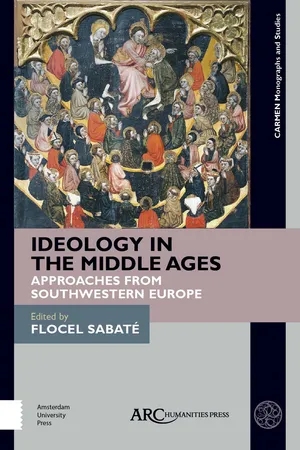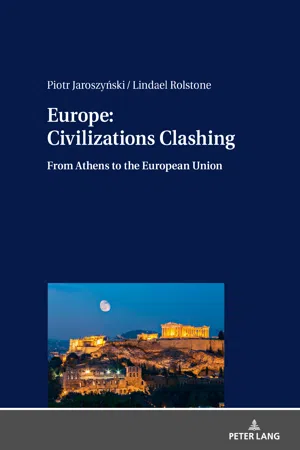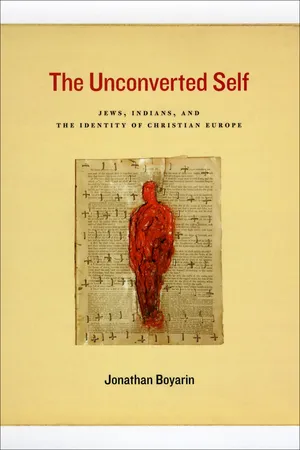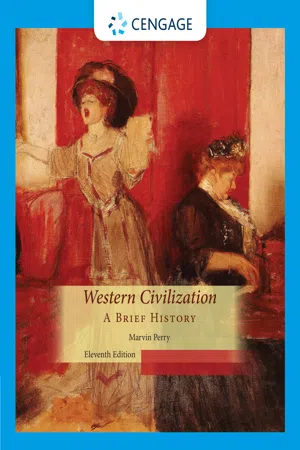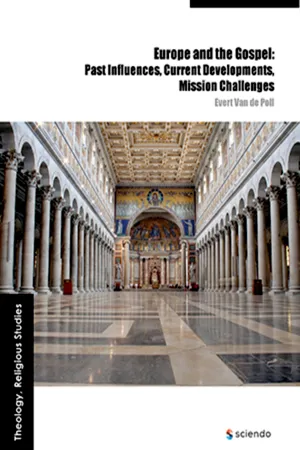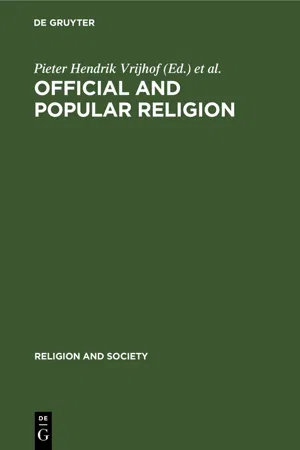History
Christianity in Medieval Europe
Christianity in Medieval Europe was a dominant force that shaped the religious, social, and political landscape. The Church held significant power and influence, playing a central role in people's lives through religious practices, education, and governance. The period also saw the spread of Christianity through missionary work and the construction of grand cathedrals and monasteries.
Written by Perlego with AI-assistance
Related key terms
1 of 5
7 Key excerpts on "Christianity in Medieval Europe"
- eBook - PDF
Ideology in the Middle Ages
Approaches from Southwestern Europe
- Flocel Sabaté(Author)
- 2019(Publication Date)
- Arc Humanities Press(Publisher)
19 Christian-ity and royal power were intertwined everywhere: sovereigns imposed Christian belief, in all its facets, violently if necessary. 20 From the seventh century onwards, both domes-tic policy and the extension of frontiers, as we see with the Franks, entailed imposing Christian faith in its spiritual component which, at the same time, served as a means of justifying and uniting society. 21 Christianity started to give sense to all aspects of medieval society. It worked to adapt behaviours, fears, and beliefs and drew directly from popular or traditional beliefs, 22 especially regarding the interpretation of nature, the environment, and interac-tion with the afterlife. 23 Sovereigns and lords not only enjoyed power through divine will but also became responsible for supervising the religious obligations of the people and the behaviour of the clergy, as Carolingian theocracy and its pax Christiana expressed to the full. 24 Extending one’s territorial domains was to extend Christendom: war-monger-ing and evangelization went hand in hand on all the frontiers of the tenth and eleventh centuries, whether those established by the Vikings in Normandy 25 or in the Iberian 17 Luis A. Garcí�a Moreno, “España y el Imperio en época teodosiana. A la espera del bárbaro,” in I Concilio Caesaraugustano. mdc aniversario , ed. Guillermo Fatás (Zaragoza, 1981), 29–30. 18 Averil Cameron, The Mediterranean World in Late Antiquity ad 395–600 (London, 1993), 57–80. 19 E� milienne Demougeot, L’Empire Romain et les Barbares d’Occident (IVe–VIIe siècles) (Paris, 1988), 327–35. 20 Noël-Yves Tonnerre, Être chrétien en France au Moyen Âge (Paris, 1996), 11–25. 21 Bruno Dumézil, Les racines chrétiennes de l’Europe. Conversion et liberté dans les royaumes barbares Ve–VIIIe siècle (Paris, 2005), 359–466. 22 Michel Rouche, “Alta Edad Media Occidental,” in Historia de la vida privada , ed. Philippe Ariès, Georges Duby (Madrid, 1992), 94–137. - eBook - PDF
Europe: Civilizations Clashing
From Athens to the European Union
- Piotr Jaroszynski, Lindael Rolstone(Authors)
- 2019(Publication Date)
- Peter Lang Group(Publisher)
75 The practice of Christianity had spread over most of three continents, of which the largest part belonged to Africa. In Europe, Christianity still cov- ered a small piece of it, while in other geographical locations; it covered a large area of land. In the Europe of the fourth century, Christianity cannot be identified with Europe. 76 As time continued throughout history, Christian thinking, philosophies, and values were challenged. In the seventh century, a new religion appeared on the world scene, that of Islam. A Muslim is a person who practices Islam, believing that the word of God (Allah) was spoken to the prophet Muhammad, through the angel Gabriel. This new religion was expansive. Islam chose to honor their faith through the conquering of other nations. Islam quickly conquered at first Asia Minor and North Africa. By the begin- ning of the eighth century, Islam had conquered Spain. Historically, Christians have had to defend themselves against Muslim invasions. The Holy Wars, although there were examples of many evils connected with them, were formed with the intention of regaining what was lost for the Christians who lived in territories defeated by Muslim invasions. 77 The Catholic Church in the middle ages was the collective, and uniting religious institution in Europe. Popes during the middle ages carried much 74 The Latin term for Father of Europe is “pater Europae” Charlemagne was given this name because he was able to unify Europe, form a pan European identity, and bring an end to the dark ages. 75 Mare nostrum, (Orosius) was a latin word which meant “our sea”. The term was used to refer to the Mediterranean Sea. 76 Boer, Europe, pp. 21–2. 77 Thomas Madden: “Understanding the Crusades” Dr. Madden discusses myths and misconceptions connected with the crusades. www.lighthousecatholicmedia. org: CD. Religion Infuences Culture 62 political power and influence. - Virginia Garrard-Burnett, Paul Freston, Stephen C. Dove(Authors)
- 2016(Publication Date)
- Cambridge University Press(Publisher)
34 3 Religion in the Pre-Contact Old World: Europe Carlos M. N. Eire Late Medieval Europe: An Age of Faith? In 1492, European civilization was deeply religious. To say this or to assert that this was “an age of faith”– a generalization made by many a history textbook – is not to say that Europeans were necessarily pious, or that they lived up to their ideals, or that they understood or believed the doctrines professed by their Church. Religion was simply there. It was as unavoidable as the air every- one breathed or the words they spoke. In many ways, religion functioned as a language of sorts in premodern Europe: it was a means of making all human interaction intelligible according to a certain set values, a means of making sense of life and of imposing a certain sense of order on the world. Experts on European religion agree on one issue: religious devotion increased during the fifteenth century. Definitely the evidence is overwhelming. But this is where agreement ends. Some historians tend to see this increased fer- vor as hollow and anxious and ripe for reform 1 ; others see it as robust and satisfy- ing. 2 Some perceive the clergy and their flocks as sharing a common piety 3 ; oth- ers detect a great gulf between them. 4 Where some discern genuine Christian fervor, others find far too many surviving pre-Christian elements. Some have gone as far as to argue that much of late Medieval religion was “magical,” 5 while 1 Johan Huizinga, The Autumn of the Middle Ages (Chicago: University of Chicago Press, 1980); Bernd Moeller, Imperial Cities and the Reformation (Philadelphia: Fortress Press, 1972); Steven Ozment, The Reformation in the Cities (New Haven, CT: Yale University Press, 1975). 2 Eamon Duffy, The Stripping of the Altars (New Haven, CT: Yale University Press, 1992); John Bossy, Christianity in the West, 1400–1700 (New York: Oxford University Press, 1985).- eBook - PDF
The Unconverted Self
Jews, Indians, and the Identity of Christian Europe
- Jonathan Boyarin(Author)
- 2009(Publication Date)
- University of Chicago Press(Publisher)
C h a p t e r t h r e e Christendom Institutionally, the Christendom (Christianitas) defined by eleventh-and twelfth-century clerics was a unitary whole with a center, Rome, and boundaries that were to be both defended against external enemies—the pagans and infidels— and extended until they encompassed the entire world (Universitas) . The Church was like a mountain destined to fill all the space on earth, gradually eating up territory until it and the world were one. In this sense, Christendom was an institutional entity that steadily affirmed its differences against the outside—the Orthodox, Judaism and Islam—and a universalist utopia that accompanied, justified, and spurred on the expansion of the Latin west in the eleventh and twelfth centuries. Dominique Iogna-Prat , Order and Exclusion: Cluny and Christendom Face Heresy, Judaism, and Islam (1000–1150) As Robin Lane Fox has warned us, in the opening pages of his vivid book, Pagans and Christians , the brilliant reign of Constantine “was only a landmark in the history of Christianisation, that state which is always receding, like full employment or a garden without weeds.” Peter Brown, Authority and the Sacred: Aspects of the Christianization of the Roman World Late medieval Christendom was understood not merely as the extent of terri-tory ruled by Catholic monarchs, but also as the space wherein Catholic faith held sway. In that sense, just as being Christian was never a stable identity but inherently always a work in progress, Catholic-ruled territories still had to be Christendom 55 regularly, if not continuously, made and remade into part of Christendom. This permanent unsettlement, combined with the mandate to spread the Gospel to all of humanity, made Christendom not so much a contained space as a project. The more the ambition to Christianize the world came to the fore, the more embarrassing became the anomalous persistence of Jewish commu-nities “within” Christendom. - eBook - PDF
- Marvin Perry(Author)
- 2015(Publication Date)
- Cengage Learning EMEA(Publisher)
Medieval theologian-philosophers fashioned Christian teachings into an all-embracing philosophy that represented the spiritual essence and the distinctive style of medieval civilization. They perfected what Christian thinkers in the Roman Empire had initiated and what the learned men of the Early Middle Ages had been groping for: a synthesis of Greek philosophy and Christian revelation. ❖ 7. What is the legacy of the Middle Ages to the modern world? 8. How does the characteristic outlook of the Middle Ages differ from that of the modern age? Copyright 2016 Cengage Learning. All Rights Reserved. May not be copied, scanned, or duplicated, in whole or in part. Due to electronic rights, some third party content may be suppressed from the eBook and/or eChapter(s). Editorial review has deemed that any suppressed content does not materially affect the overall learning experience. Cengage Learning reserves the right to remove additional content at any time if subsequent rights restrictions require it. 156 R EVIVAL OF L EARNING In the late eleventh century, Latin Christendom began to experience a cultural revival; all areas of life showed vitality and creativeness. In the twelfth and thirteenth centuries, a rich civilization with a distinctive style united the educated elite in the lands from Britain to Sicily. Gothic cathedrals, an enduring testament to the creativity of the re-ligious impulse, were erected throughout Europe. Universities sprang up in several cities. Roman authors were again read and their style imitated. The quality of written Latin—the language of the church, learning, and education—improved, and secular and religious poetry, both in Latin and in the vernacular, abounded. Roman law emerged anew in Italy, spread to Northern Europe, and re-gained its importance (lost since Roman times) as worthy of study and scholarship. Some key works of ancient Greece were translated into Latin and studied in universities. - eBook - PDF
Europe and the Gospel
Past Influences, Current Developments, Mission Challenges
- Evert Van de Poll(Author)
- 2013(Publication Date)
- De Gruyter Open Poland(Publisher)
Evert Van De Poll 2 3 5 Chapter 14 Chapter 14 The Mixed Balance of History The legacy of Christianity is not altogether glorious. There are things to be proud of; there are also things to be ashamed of. Everyone involved in communicating the Gospel in one part of Europe or another will have the same experience: so many people want to stay away from the message because of the negative picture of Christianity in general, and church institutions in particular. The negative record of Christians is always a major hindrance for evangelism, but nowhere is the criticism levelled against Christianity as widespread and as strong as in Europe. The negative image of Christianity is largely based on its past record. The problem is that this characterization contains a considerable amount of truth. Europe is marked by the influence of Christianity, but not always in a positive way. Churches have often played a dubious role, to say the least. One thinks, for example, of the violent persecution of so-called heretics, dissenters and non-conformists by the combined forces of church and state authorities. Today Europeans have lost much of the feeling of superiority they had in the past. Instead, they have become critical of their own history. In this context, people are very much aware of what church leaders and lay Christians have done wrong in the past. Sadly, blame is often levelled against European Christianity as a whole. Sometimes Christianity is discredited as far as its place in the public sphere is concerned. Many secularised people hold to the opinion that it is alright for people to practice their faith in the private sphere, but don’t want the church to try and dominate the public sphere, or influence the political debate so as to impose its views. Enough of that has happened in the past. Generalisations always fall short of reality. The categorical criticisms levelled against ‘the church’ are no exception. - eBook - PDF
Official and Popular Religion
Analysis of a Theme for Religious Studies
- Pieter Hendrik Vrijhof, Jacques Waardenburg, Pieter Hendrik Vrijhof, Jacques Waardenburg(Authors)
- 2019(Publication Date)
- De Gruyter Mouton(Publisher)
80 W.Th.M. Frijhoff od of intense purification in which above all the churches of the Reformation showed the lead. But the facts are much more complex. Is it at all meaningful to make a distinction between popular and official religion with respect to the late Middle Ages; or rather, do these terms indicate a similar state of affairs as they do by the end of the eighteenth cen-tury? Have not the canons on the officially prescribed or accepted religious behaviour changed considerably over the course of time, also and particularly within the Roman Catholic Church? And have not thereby changes set in, in what is without doubt unjustly of-ten called 'popular' religion, it being regarded as a kind of residual phenomenon? It appears to us that in medieval Christianity a high degree of integration between the two forms of experience was achieved, and that it is characteristic of the Early Modern Times that a number of practices become gradually increasingly marginal: these prac-tices are then qualified as 'popular' because they no longer fit into the social-cultural scheme of values expounded by an élite, which consciously re-gards itself as being above the masses in so far it has emancipated itself through its knowledge from the 'irrational' collectivity. It is important to examine this thesis more closely. 2.1 Let us first note that one thread runs throughout the entire religious history of western Europe from the fourteenth until the eighteenth century, namely the idea of Christianity (15) as a traditional mental and social model of organisation, a model that has its roots far back in early medieval times. According to this idea, the state is a Christian state, the church a religious community and the dominant religion must necessarily be that of the sovereign. The Dutch Republic only seems to be an exceptional case; for, even there, notwithstanding any unavoidable tolerance,
Index pages curate the most relevant extracts from our library of academic textbooks. They’ve been created using an in-house natural language model (NLM), each adding context and meaning to key research topics.
